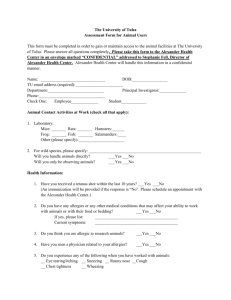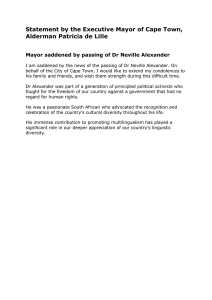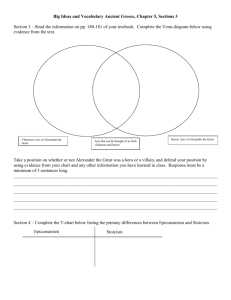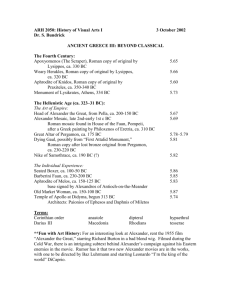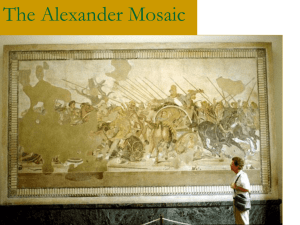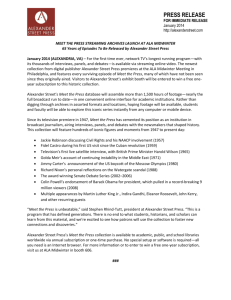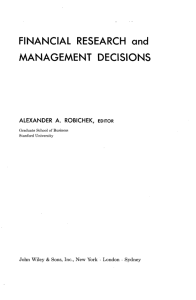Document 10465412
advertisement
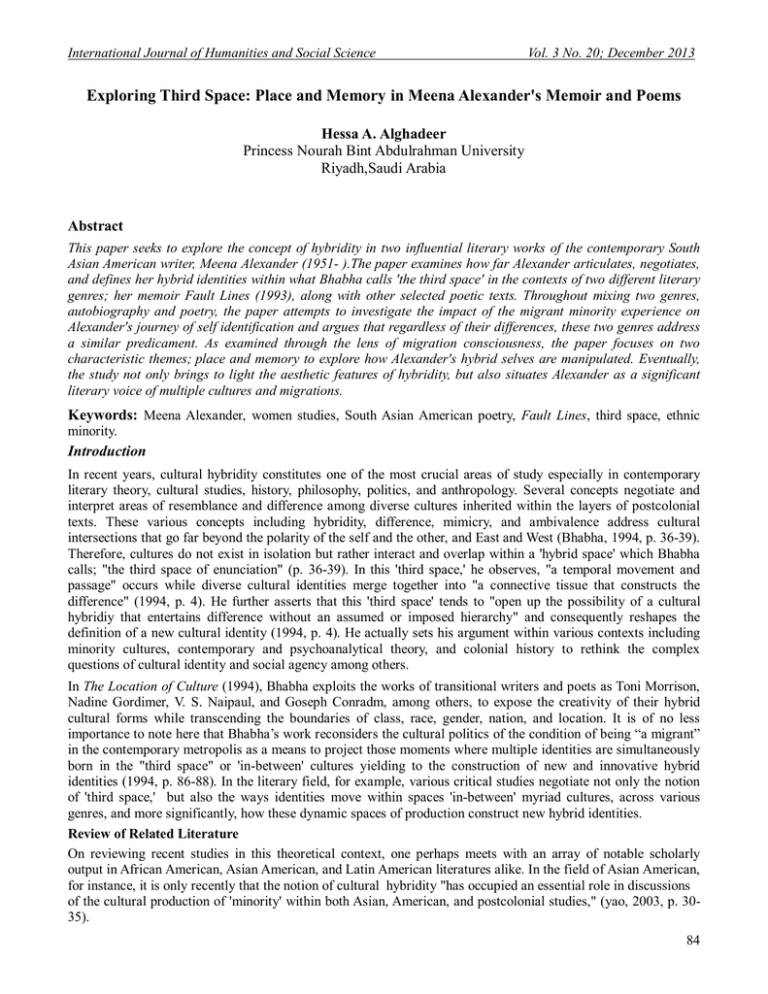
International Journal of Humanities and Social Science Vol. 3 No. 20; December 2013 Exploring Third Space: Place and Memory in Meena Alexander's Memoir and Poems Hessa A. Alghadeer Princess Nourah Bint Abdulrahman University Riyadh,Saudi Arabia Abstract This paper seeks to explore the concept of hybridity in two influential literary works of the contemporary South Asian American writer, Meena Alexander (1951- ).The paper examines how far Alexander articulates, negotiates, and defines her hybrid identities within what Bhabha calls 'the third space' in the contexts of two different literary genres; her memoir Fault Lines (1993), along with other selected poetic texts. Throughout mixing two genres, autobiography and poetry, the paper attempts to investigate the impact of the migrant minority experience on Alexander's journey of self identification and argues that regardless of their differences, these two genres address a similar predicament. As examined through the lens of migration consciousness, the paper focuses on two characteristic themes; place and memory to explore how Alexander's hybrid selves are manipulated. Eventually, the study not only brings to light the aesthetic features of hybridity, but also situates Alexander as a significant literary voice of multiple cultures and migrations. Keywords: Meena Alexander, women studies, South Asian American poetry, Fault Lines, third space, ethnic minority. Introduction In recent years, cultural hybridity constitutes one of the most crucial areas of study especially in contemporary literary theory, cultural studies, history, philosophy, politics, and anthropology. Several concepts negotiate and interpret areas of resemblance and difference among diverse cultures inherited within the layers of postcolonial texts. These various concepts including hybridity, difference, mimicry, and ambivalence address cultural intersections that go far beyond the polarity of the self and the other, and East and West (Bhabha, 1994, p. 36-39). Therefore, cultures do not exist in isolation but rather interact and overlap within a 'hybrid space' which Bhabha calls; "the third space of enunciation" (p. 36-39). In this 'third space,' he observes, "a temporal movement and passage" occurs while diverse cultural identities merge together into "a connective tissue that constructs the difference" (1994, p. 4). He further asserts that this 'third space' tends to "open up the possibility of a cultural hybridiy that entertains difference without an assumed or imposed hierarchy" and consequently reshapes the definition of a new cultural identity (1994, p. 4). He actually sets his argument within various contexts including minority cultures, contemporary and psychoanalytical theory, and colonial history to rethink the complex questions of cultural identity and social agency among others. In The Location of Culture (1994), Bhabha exploits the works of transitional writers and poets as Toni Morrison, Nadine Gordimer, V. S. Naipaul, and Goseph Conradm, among others, to expose the creativity of their hybrid cultural forms while transcending the boundaries of class, race, gender, nation, and location. It is of no less importance to note here that Bhabha’s work reconsiders the cultural politics of the condition of being “a migrant” in the contemporary metropolis as a means to project those moments where multiple identities are simultaneously born in the "third space" or 'in-between' cultures yielding to the construction of new and innovative hybrid identities (1994, p. 86-88). In the literary field, for example, various critical studies negotiate not only the notion of 'third space,' but also the ways identities move within spaces 'in-between' myriad cultures, across various genres, and more significantly, how these dynamic spaces of production construct new hybrid identities. Review of Related Literature On reviewing recent studies in this theoretical context, one perhaps meets with an array of notable scholarly output in African American, Asian American, and Latin American literatures alike. In the field of Asian American, for instance, it is only recently that the notion of cultural hybridity "has occupied an essential role in discussions of the cultural production of 'minority' within both Asian, American, and postcolonial studies," (yao, 2003, p. 3035). 84 International Journal of Humanities and Social Science Vol. 3 No. 20; December 2013 Furthermore Yao (2003) not only underlines in his article; "Towards a Taxonomy of Hybridity" the significance and vitality of Asian American cultural production, but also calls out for future critique to bring to light what he describes; "the remarkable variety of aesthetic techniques and cultural reference" of Asian American poetry in particular (p. 30). Moreover, other recent discussions delving into the correlation between the concept of hybrid cultures and 'minority' literature from a historical perspective as in Patell's (2008) study; "Emergent Ethnic Literatures; Native American, Hispanic and Asian American," consider the concept of hybridity as "a conceptual leap forward for theorists of minority discourse, postcoloniality, and emergent literatures" (p. 358). Patell further argues that "these literatures negotiate the borderlines between traditional cultures, [and] live without frontiers exploring what Bhabha has called "the third space of enunciation" (2008, p. 358-359). Other influential studies articulate a variety of Asian American literary genres from a migrant's perspective like Lowe's (1996) Immigrant acts: on Asian American cultural politics. The writer remarks that most works produced by immigrant writers are largely considered ''alternatives to national cultural forms … a meditation of history, the site through which the past returns and is remembered, however, fragmented, imperfect, or disavowed" (x). More interestingly, Ponzanesi compares the work of prominent Asian American writers in her significant book; Paradoxes of Postcolonial Culture: Contemporary Women Writers of the Indian and Afro-Italian Diaspora (2004). She examines the work of specifically Indian women writers and poets like; Meena Alexander, Bharati Mukherjee, and Sunetra Gupta to Afro-Italian immigrant women as Maria Abbebù, Ermina dell'Oro, Ribka Sibhatu, and Sirad Hassan to explore dissymmetrical characteristics that uncover the contradictions of the cultural experience of ethnic minority. Regardless of the minor position of minority writers, Ponzanesi suggests, Anglo Indian women writers have reached "major status" and achieved "canonical recognition" (2004, p. 15). In effect, there are remarkable shifts in the concept of hybridity in recent postcolonial scholarships. While early studies focus primarily on subjects of hybridity in colonized countries, several recent theorists shed more light on migrant or diasporic communities living in alien countries. In this sense, America plays the role of the host country in which the migrant community remains a minority (Fludernik, p. 1998). Methodological Approach It is significant to mention, therefore, that the present study is primarily concerned with analyzing some literary works written by Meena Alexander's who is considered one of the prominent South Asian American migrant women writers.I draw on two different literary genres; Alexander's memoir, Fault Lines (1993), along with a variety of poetic selections related to some of her influential volumes including River and Bridge (1995), Illiterate Heart (2002), Raw Silk (2004), and her prose and poetry book, The Shock of Arrival: Reflections on Postcolonial Experience (1996). From a migrant perspective, the paper focuses on two recurrent themes in Alexander's writing; place and memory. I attempt to examine how Alexander articulates, questions, and defines her hybrid identities in the light of what Bhabha calls "the third space of enunciation" (1994, p. 37). In effect, the act of writing 'third space' is an intricate task or rather "an ambivalent contact zone" into what Pratt remarkably depicts as "disparate cultures meet, clash, and grapple with each other" (1992, p. 4). In this manner, I will put forward Bhabha and Pratt conceptions of the 'third space' and 'contact zone' along with other vital issues including nationality, culture, gender, and race through which to explore and examine the contexts where Alexander constructs her multiple identities. My concern in this study, therefore, is to shed light on how these two different genres, autobiography and poetry, emphasize Alexander's journey of self identification despite their difference by addressing a similar predicament. Migrant Minority Experience and Alexander Through close readings of several literary texts addressing the migrant minority experience in contemporary South Asian American women poetry, one seems to encounter at the crossroads, different settings, languages, histories, traditions, and genres alongside a fusion of diverse cultures. Among these established contemporary women writers are; Meena Alexander, Sujata Bhatt, Monika Varma, Sunita Jain, and Imtiaz Dharkher, Monika Verma, and many others. Apart from cultural, regional, and historical differences, many South Asian American women poets explicitly share prevalent subject matters and themes including identity formation, migratory experiences, predicament of dislocation, loss of homeland, ethnicity, and memory. In so doing, not only do they enrich the landscape of minority poetry in America, but also contextualize the complexity of migrant minority experience in a foreign country. In fact, exploring the literary production of these women poets requires an understanding of the paradoxical interrelation between the concept of identity and migrant writing in terms of how these women writers articulate the spaces ‘in-betweenness’ (Bhabha, 1994) in their literary texts, along with race, ethnicity, and gender. 85 International Journal of Humanities and Social Science Vol. 3 No. 20; December 2013 Since any individual's essentialist identity usually bears 'coherent' and 'unified' meanings that entirely differs from identity formation associated with the space of minority writings, Sommer (1998) explains, the minority space entails patterns of multiple subjectivity navigating more than one culture (p. 301-303). These women poets thus no longer celebrate national boundaries, but rather the 'third space' which becomes their evocative space of renewal, going far beyond the hierarchy of center and periphery. By a similar token, the pervasive sense of dislocation promoting agency and empowerment launches new dialects of creativity and also resists the confines of minority status. This is again in keeping with Alexander's idea that "those who feel displaced as minorities within their own land, have created a pulsing, throbbing net of meanings within which the poet can exist" (2009, p. 4). Not only does the use of numerous literary genres, modes, and "net of meanings" align with fragmented narratives often one heard in Meena Alexander's space 'in-between' cultures, but also tie together what it means to be an Indain woman living in the metropolis of a shifting world. Alexander was born in Allahabad, India, raised in Allahabad, Khartoum, and Kerala, educated in Sudan and Britain, married and settled in New York City. Since then, Alexander has become a prolific author producing a variety of collections of poetry, works of fiction, literary memoirs, lyric essays, and literary criticism. In keeping with a past jagged between changes and restless moves, her sensuous lyrics revolve around myriad experiences colored with agonies of displacement and hopes of relocation. Among the prominent aspects of her work are perhaps what Caponetto (2005) underlines; "the challenges of negotiating multiple cultural identities and the patterns migrant women follow in trying to reconcile their cultural past and present" (p. 498).These challenges and patterns are imbued luminously into the fabric of Alexander's literary work through crucial issues such as identity and hybridity, the self and the other, longing and belonging, memory and marginality, and violence and terror. Though she has expressed her themes in conjunction with a writer's powerful sense of subjectivity's split in Hindi, Malayalam, and French, yet they still largely appear in English throughout her notable literary works 1.Within the contexts of minority migrant experience, Alexander is engaged primarily with identity formation,"For years, she has used her poetry and fiction to piece together a cohesive identity to figure out what it means to be a woman born in India, educated in Engalnd, living in America" (Young, 1997, B8). Additionally, in coming to terms of being a migrant writer caught into various intersecting spaces, Alexander introduces herself in different facets; Asian American, postcolonial, immigrant, women of color, feminist, and Indian. These multiple facets, in turn, are endowed with audible voices introducing what Alexander herself asserts:"all this is part of our task, part of the violent, fractured worlds that we must etch into beauty" (1993b, p. 624). Straddling between cultures and countries, from India, through Sudan, England, and America, is a poignant experience initiating multiplicity and dislocation in Alexander's past and present, and consequently reframing both her life and writing career. Against a backdrop of dissimilar geographical territories, Alexander depicts several migratory experiments to convey numerous literary languages expressions of the hybrid condition. Whilst rooting these expressions in the body of her migrant texts, she not only negotiates the fractures of her selfhood, but also engages into endless scenarios of identity formation. Alexander never isolates herself within the margins of her Indian identity, but rather employs other locales, cultures, and in acute narratives of a 'third space' where selfexploration is at the forefront. In so doing, she stitches together the fragments associated with migrant lives, searches for a more definite integrated identity, and sets out through distinct poetic voices to signify an authentic Asian American identity. The act of writing 'the third space' hence is remarkably caught in Alexander's portrayal of her migrant self when she tells;"A migrant life lived through continents, across waterways and islands, creates the space where I write" (2007, p. 45). Analysis of Alexander's Fault Lines: Thematic Concerns For the sake of analyzing Alexander's work, it is vital to stage her intellectual memoir; Fault Lines (1993a) in the forefront, since it is considered" a candid and poignant examination of all her losses, the vertigo of displacement, the liminality of exile, the shock of being a woman without history in this new world" ( Knippling,1996 p. 100). The memoir moreover draws upon one of the primary concerns of Alexander's writing, i.e., self creation against an agitating history of dislocation. In this sense, the memoir may serve to foreground the analysis of most of her poems addressing parallel themes. 1 River and Bridge (1996a), Illiterate Heart (2002a), Raw Silk (2004), Indian Love Poems (2005), and Quickly Changing River (2008). Prose and poetry include; The Shock of Arrival: Reflections on Postcolonial Experience (1996b), and Poetics of Dislocation (2009). 86 International Journal of Humanities and Social Science Vol. 3 No. 20; December 2013 In what follows, for instance, Alexander (1993a) questions the agony of rewriting the fragments of the migratory experience when she wonders: And that of all the cities and small towns and villages I have lived in since birth: Allahabad, Tiruvella, Kozencheri, Pune, Delhi, Hyderabad, all within the boundaries of India; Khartoum in the Sudan; Nottingham in Britain; and now this island of Manhattan? How should I spell out these fragments of a broken geography? (p. 2) As a postcolonial female subject on the periphery, the feeling of dislocation projecting a cracked body is often rigorous. On taking into account her position as an Indian living in the city of New York, Alexander inhabits a critical 'third space' where two cultures; Asia and America are fused within the multiplicity of place, and memory. However, this state of hybridity is not about the issue of mixing two or more cultures together, but rather about the wide range of identities negotiated for the sake of inducing "other positions," like what Bhabha (1990, p. 211) underscores; "the importance of hybridity is not to be able to trace two original moments from which the third emerges; rather hybridity to me is the 'third space' which enables other positions to emerge" (1990, p. 17). Bearing this in mind, Alexander is obviously aware of the impact of living in the fragile space between identity and place where several positions of the postcolonial, migrant, or minor subjects do emerge; "who are we? What selves can we construct to live by? How shall we mark our space?" (1993a, p. 174). Here, she does speak not of a personal but communal predicament of migrant minority in America and probably elsewhere which becomes a glaring metaphor hunting the majority of her poetry. These three successive questions reflect Alexander's fading identity and remark at the same time a hybrid aesthetic that enables her to rearticulate the multiple facets of her selfhood on the edge of her world. From the perspective of an educated Indian woman writer, settling abroad, mainly in America, one may locate complex translated spaces of difference in her writing where, in terms of what Zapf' asserts; "hybridity is most often invoked and praised by migratory or minority intellectuals with multiple identities" (1999, p. 304). In most volumes of her poetry, Alexander attempts to give voice to many migrant subjects, especially south Asian American, inhabiting cultural gaps whom racism, history, and culture have made unheard. Within the layers of the migrant narrative, therefore, Alexander's oeuvre navigates the juncture between social, physical, and psychic sites of her world. In effect, the experience of dwelling on the borders of a multicultural metropolis like the city of New York, serves as Alexander's muse inspiring a wide range of remarkable poems. In practice, situating the 'third space' on the poetic stage, the 'in-between' mode is thus dramatic whenever Alexander contemplates her uprooted position in a hierarchy society. In the confessional tone of her memoir, Alexander relates many incidents where her fragmentary conditions are exposed; "[t]hat's all I am, a woman cracked by multiple migrations. Uprooted so many times she can connect nothing with nothing"(1993a, p. 3). Alexander obviously depicts here the dislocated self which is caught in 'the third space,' at the crossroads of different cultural arenas. The contact zone is more complex in relation to her ethnic identity which is seen implicitly, in her reference to rootlessness, disturbing history, and an overwhelming sense of emptiness. In addition, Alexander intentionally distances herself from the confines of regional territories and undermines a travelling identity revealing the anguish of displacement and the split between body and mind. From the lens of a migrant minority, Alexander (1993a) dwells upon this issue in her memoir and depicts its poignant impact on her psyche: Why did I leave India? Why did I feel as if there still were a part of my story that had to be forged through departure? I am tormented by the question. All I knew was that something had broken loose from inside me, was all molten. (p. 146) As the previous lines have shown, the narrator's life revolves around a puzzle of constant movements, departures, and negotiations that she can neither resolve nor abandon. The agony hence penetrates beneath the surface and perpetuates the loss of a frail uprooted body. Actually, one may recognize easily "Alexander's yearning for physical, imaginative, and spiritual space that she can call her own as a minority female artist is conjoined with her self-reflexive, stylized questions about how to live her life as an Indian American"(Shankar, 2001, p.305).Yet this yearning seems more than figments of other lingering emotions of regret, nostalgia, and acute loss that her mind and imagination fail to resist. 87 International Journal of Humanities and Social Science Vol. 3 No. 20; December 2013 Alexander (1993a) not only recreates a collage of personal memories of childhood, family, and India, but also signifies the fusion of internal and external clashes between the self and the whole world as shown in the following lines: Where did I come from? How did I become what I am? How shall I start to write myself, configure my "I" as Other, image this life I lead, here, now, in America? What could I ever be but a mass of faults, a fault mass? (p. 3) Alexander often negotiates her position and comprehends her 'third space' and what it truly means for a migrant Indian woman and writer to reside at the crossroads of disparate cultures. Here she negotiates vital issues such as identity, belonging, ethnicity, and racism whenever she attempts to locate herself within a fractured space between India and America, between the place of origin and that of residence, between the exotic world and the modern world. In this spirit, being an ethnic and racial minority amidst the vertigo of the "racialist metropolis" of New York City, Alexander recognizes that her vision of the world, herself, and others is actually a chain of complex questions. These questions are associated with female agency, privilege, belonging, exploitation that perpetuate her act of meaning making as well as her condition of 'in-betweenness' which becomes an inescapable part of a living reality. In this intimidating urban space, she posits the presence of a racialized female body marked by difference and "a mass of faults." In a similar manner, the "I" pervades the narrative into different shades of colors, yet merging to draw the visage of a single portrait of a lone perplexed female persona. In this multilayered context, multiple identities within a communal space including that of the female, the migrant, the poet, the postcolonial, the colored, and the Other are caught in an engaging confrontation only to learn that their world is inhabited by diasporic subjects like themselves who are incapable to figure out what 'settlement' or 'arrival' may signify or even suggest. Another script of hybridity is spelled out within the layers of the narrative of Fault lines (1993a), but this time to disclose the realities underneath the black female migrant body when Alexander tells: But when she approaches me, this Other who I cover her nakedness, I see quite clearly what I had only guessed at earlier; she had no home, no fixed address, no shelter. But it is clear that she is a nowhere creature. (p. 30) The previous internal conflict addressing Alexander's position is perhaps determined here when the narrator and the Other extend their relations to uncover the never flawless body from one hand and the non temporal status of "a nowhere creature" from the other. The space here is inhabited by transitional identities meeting into a contact zone that conjures up a desire for assimilation with the Other regardless of her naked vulnerability. What makes these lines more problematic is the dilemma of dislocation; the longing for belonging which haunts and fuses the narrative flow while the unspoken agony of self/Other is revealed. On arguing similar spaces where visions are multiple and new definitions of the self and Other are constructed, Bhabha's discussion is remarkable to highlight here: " [i]t is in this space that we will find those words with which we can speak of Ourselves and Others. And by exploring this hybridity, this 'Third Space', we may elude the politics of polarity and emerge as others of our selves" (1994, p. 209). Despite of the silence and gaps the above lines bear, the voice of the self merges with the voiceless Other within the confines of one shared site. In this sense, Alexander translates a problematic of identification between the migrant self, Other, and the place; home or any anonymous location in her world. It seems that Alexander configures her "I" as Other which she sees at this time "quite clearly" and writing the truths of her dark female self in this mode accordingly. In another chapter of her memoir entitled "Transit Lounge," Alexander (1993a) relates her migrant experience of fleeing India to reside in the throbbing heart of the first world, in New York city, and specifically in the Long Island of Manhattan where it becomes the sight and sound of much of her literary output: In Manhattan it is hard to make the bits and pieces hold together. Things are constantly falling apart. The city is dispersing itself, jolting, juggling its parts. There is no ideal of poise in its construction, just the basting together of bits. Sometimes bits burst open, split apart, and one does not quite know how to go on. How to construct a provisional self to live by. (p. 177) The narrator is obviously depicting a cosmopolitan mélange here evolving into fragile structure and falling fractures. Whilst engaging in an implicit clash with the city, the ambivalent self is disoriented evermore by the violent and racial spaces of Manhattan. The text thus merges space, body, and emotions into uncanny relations that let the narrator murmurs; "how to construct a provisional self to live by?" 88 International Journal of Humanities and Social Science Vol. 3 No. 20; December 2013 The narrator, hence voices here the ceaseless distance that reminds her of the irrational spaces she inhabits. On dwelling on her status on borderlines in a poem entitled; "Civil Strife," Alexander (2002) encounters the self which is no longer identified nor exists: "the bridge of belonging/ shattered,/ cherished flesh/ burst into shards of thingness"(p. 32, 33-36). Alexander's failure to plant herself into a foreign soil illustrates what Shankar observes; "[t]hrough her autobiographical writings, she utilizes her aesthetic vision and voice to search for, define, and claim her fractured selves and identities within new geographic and psychological landscapes" (2001, p. 287).In effect, this split subjectivity engenders multiple selves along with new meanings, appropriate definitions that characterize not only her autobiographical writing but her poetry as well. In effect, Alexander alters the intimate form of the memoir to serve her hybrid position and draws on the lyric to manipulate private and public spaces. She renders the private, sentimental form of the lyric into an innovative type where she can question issues of intricate legacies of migrant minority including dislocation, home, language, violence, and memory. While mapping different geographies, most of her lyrics accommodate multiple selves, depicts various facets of identity formation, and configures Bhabha's 'third space'’ "which enables other positions to emerge" (1990: 211). Analysis of Alexander's Poetic Oeuvre: Thematic Concerns Alexander (1992), who believes that Asian American aesthetics is largely an aesthetics of dislocation, portrays in what follows the space she inhabits in America: [t]he other is that we have all come under the sign of America. In India, no one would ask me if I were Asian American or Asian. Here we are part of a minority, and the vision of being “unselved” comes into our consciousness. It is from this consciousness that I create my work of art. (p. 26-27) From the perspective of an "unselved" being, Alexander writes her lyrics to fashion the multifaceted sort of poetics associated with the canon of minority migrant poetry. According to her, poetry works as an effective means to dispute her fragmentary presence against two opposing cultures, two different locales which she frequently attempts to reconcile. It is in this sense that poetry and place emerge and intermingle repeatedly in numerous poems as prominent themes and settings. She depicts this predicament when she states that "I have in me these worlds that need to be brought together- very crudely, India and America- and sometimes I feel that I keep treading the edge of the fault line in between (as cited in Ling, 2000, p. 84). As a postcolonial minority subject on the periphery of the world, Alexander believes that "the act of writing makes up a shelter," (1993b, p. 621) where poems are no longer figments of fantasy and desires but rather sites of real places and homelands. The act of writing itself works as perhaps the harbor that rescues her from the shards of diaspora and homelessness. Her lyrics work as alternatives to her lost history; "I depended on the poems irruptions of the imaginary to make an internal history for me" (Alexander, 1993a, p. 125). In this spirit, her lyrical poetry works as a tactic of survival and struggle as she herself claims;"[m]y sense of poetry, even in its uttermost privacy, drew strength from struggle, from tumult" (1993a, p. 117). It moreover serves to empower her minor position and to locate an agency to her gendered identity. A wide range of Alexander's poetic texts, mainly lyrics, explores the South Asian American experience and exemplifies how hybridity and difference converge into discourses focusing on moments 'in –between'. Alongside female protagonists, Alexander employs myriad themes, structures, language, expressions, and allusions to disclose the peculiarities of Indian American minority. In doing so, these poems pattern the crucial role of the fluid identities of their woman subjects within different geographical and socio-cultural milieus while at the same time embrace the complexity of their hybrid spaces. According to Alexander (2002b), any work of art has to combine the past with the present: The personal past has to be knotted up in the present. I must carry it as a bundle, bear it as a migrant might a blanket tied up with all her worldly possessions. So in this way I feel very intimately the necessity of artistic work. It is what I am called to do. (p. 33) In this light, Alexander's female figures are caught in a hybrid space that is situated in the contact spot between "here/America" and "there/India" and within drifting time zone that shifts the present to the past and vice versa. Many lyrics therefore portray and merge the sunlight in Allahabad, Tiruvella, the golden fields of rice, the Pamba River, the guava and mango trees, the scent of pepper, graveyards, churches, seminary, and the monsoon sky with the rough bricks of the walls on Broadway Street in Manhattan, Turtle Island, the park at Riverside Drive, Fifth Avenue, and Hudson River. 89 International Journal of Humanities and Social Science Vol. 3 No. 20; December 2013 In "Alphabets of Flesh," from The Shock of Arrival (1996b), Alexander portrays an experiment with hybridity, where the flow of the poetic text meditates itself to a salient conflict between an anonymous female persona and her strange world; My back against barbed wire snagged and coiled to belly height on granite posts glittering to the moon No man's land no woman's either I stand in the middle of my life. ……………….. Out of earth's soft and turbulent core a drum sounds summoning ancestors. (13, 1-8, 13-16) The previous lines deliberately reflect the fusion of the poetic text as the speaker depicts her 'third space' between two opposing worlds, the foreign world; "No man's land /no woman's either" and the familiar world of "summoning ancestors." In this Asian American context, the distance seems infinite between the two settings regardless of their dual presence in the poem. Whilst the 'in-between' mode pervades the poetic text, themes do overlap; from alienation and nostalgia, through segregation, memory, home, and loss of history. In addition to settings and themes, the speaker reflects on dissimilar roles. While the speaker holds an isolated hovering position "against barbed wire" in a deserted land, "the ancestors" "rise" and "dance" against a sturdy history of resistance: They rise through puffs of grayish dirt scabbed skins slit and drop from them They dance atop the broken spurts of stone They scuff the drum skins with their flighty heels. ("Alphabets of Flesh," 13, 17- 26) The linguistic materiality of the text contributes to outline the in- between template of the poem. Alexander uses many words and phrases such as "coiled," "middle," "turbulent core," "the broken spurts," and "skins slit," provoke the hybrid space and also capture the ambivalent zone which records two alien physical spaces alongside the speaker being torn apart between fracture identities. The speaker thus enters 'the third space' with a vague hybrid position embracing an imaginary place that may be perceived as home, or a dwelling where again her lost or probably new identity is attuned. In another significant poem of Alexander (1996a) entitled; "River and Bridge," which gives the collection its title, the speaker depicts her personal experience on dwelling at the metropolis of white America. The tone is an autobiographical-like one as it voices the personal predicament of Alexander herself where she recounts in her memoir:"often I did not recognize myself. I felt I had lost my soul: that it was sucked into the vortex of an Otherness I had no words for" (1993a, p. 164). As the poem is set in the river side district of New York City, the reader learns of the infinite distance between narrator and place right from the introductory stanza: Trees on the other side of the river so blue, discarding light into water, a flat white oil tank with HESS in black, a bridge Holzer might skim with lights – I will take her down before she feels the fear – no sarcophagus here: ("River and Bridge," 23, 1-5) 90 International Journal of Humanities and Social Science Vol. 3 No. 20; December 2013 The stanza immediately conjures up 'a third space' within the confines of bleak and dismal setting, probably the upper side of Manhattan. In most of Alexander's lyrics, the element of place communicates the poet's meaning making. While place works to connect and exclude her characters, it reveals their split subjectivities along with their agonies and fears. As shown in the previous lines, the speaker alludes explicitly to various places; the river side, the bridge, and racialized surroundings where "white" and "black" do converge. The place and its sharp components implicitly draw boundaries and borders and increase an inescapable sense of exclusion. As an anonymous female figure enters the poetic scene, the voice of the female speaker interrupts the narrative flow; "I will take her down before she feels the fear." The structure of the two lines is rendered into italics to heighten the sense of marginality or rather unbelonging. The voice belongs to a woman, one of the countless displaced female subjects in Manhattan. Being aware of the complexity to forge connections here, the voice intimately identifies with the unnamed female figure specifically in Manhattan where fear, death, and identity split shroud the destiny of its foreign dwellers. In so doing, the voice is echoing the doubling identity position that is akin to the 'inbetweenness' of the urban place itself. In the next stanza, the speaker reverses to another flashback where perhaps another tale of an unhomely woman sharing the same setting is being portrayed: I have come to the Hudson’s edge to begin my life to be born again, to seep as water might in a landscape of mist, burnished trees, a bridge that seizes crossing. ("River and Bridge," 23, 6-9) In these lines, Alexander places the female figure inside a global multicultural urban space to highlight the irony of split subjectivity enacted there. The borders get blurry as the text blends death in the first stanza with birth and new beginnings in the second, in conjunction with contradictory feelings of fear and optimism. In fact, visual images contribute to simulate the intrinsic instability of the spaces in between-ness along with acute sense of cultural differences. Images such as "a landscape of mist," "burnished trees," represent what migrant subjects uphold about the land of the American dream. In this context, the text builds upon political, social, cultural, and literary implications which Alexander echoes in the concluding stanza: But Homer knew it and Vyasa too, black river and bridge summon those whose stinging eyes criss-cross red lights, metal implements, battlefields: birth is always bloody. ("River and Bridge," 23,10-13) The allusions to "Homer" and "Vyasa" bring to mind a segment of ancient history of violence, migration and exile where Alexander's experience is seen against its backdrop. This affinity between two ancient epics; Odyssey of the Greek Homer and Mahabharata of the Indian Vyasa, on the one side, and the plight of Alexander's female personas, on the other, narrates the ordeal of shifting identities caught in the labyrinth of diaspora. The closing stanza wraps up the struggle of the female persona whose allegory of bloody birth evokes a crucial agony of unsettlement. This actually calls to mind what Shanknr (2001) notes with regard to Alexander's poetry: "Writing her-"self" into existence and claiming literary and psychic space as a means of asserting an ethnic American identity are part of what is at stake for the postcolonial diasporic writer" (p. 308). In this spirit, what the last lines essentially map out is a desolate perception of conceivably an imperial and violent terrain where bridges and rivers symbolize barren locales insofar as identity formation is interacted. In addition to place, the theme of memory features another powerful site introduced in Alexander's Fault lines alongside a number of her influential poems like; "Blue Lotus," "Art of Pariahs," "Fragile Places," among others. These texts articulate memory in relation with identity, home, and history. In this sense, they are usually abundant with allusions to specific historical geographies, and autobiographical material including her matrilineal ancestors. Her grandmother Kunjn, her grandfather Ilya, their Tiruvella's house in Kerala, childhood, postcolonial India, and the American migrant minority experience. The colonial burden and its aftermath are preserved in the memories of Alexander's ancestors where India fought her struggle wars to gain independence from the British colonial rule. These memories are dialects of broken histories as conceived by Alexander (1993b) when she observes: "Given our postcolonial histories, it seems to me that it is only in the teeth of violence that we can speak the unstable truths of our bodies, our human lives" (p. 623). In these texts, settings, characters, and events inhabit and compose some of the central components of Alexander's 'third space.' Through multiple strands of memory, Alexander attempts to thread together her past and present no matter how arbitrary they might appear to communicate meanings regarding her split identity and reconstruct spaces of belonging. 91 International Journal of Humanities and Social Science Vol. 3 No. 20; December 2013 Alexander transcends borders of continents and countries, revisits intimate places, and revives historical figures and events such as the nonviolent protests of Gandhi, Gujarati, and Sankara to interconnect fragmentary landscapes. Drawing upon the memory of matrilineal ancestors in an alien environment enables Alexander (1993a) to recreate and redefine a powerful female figure forming "a past that took the form of an ancestor" (p. 201). Her grandmother Kunjn, was born in 1894. She was a highly educated liberal woman embracing Gandhian values. Her service in women liberation through education made her one of the distinguished Nationalist Indian women at that time (1993a, p. 10-11). In the following lines, Alexander (1993a) recalls: I was filled with longing for an ancestral figure who would allow my mouth to open, permit me to speak. I skipped a whole ring of life and made up a grandmother figure, part ghost, and part flesh. She was drawn over what I had learnt of grandmother Kunju. I imaged her: a sensitive, cultured woman; a woman who had a tradition, and a history - precisely what I lacked; a woman who had lived to witness the birth pangs of a nation. (p.15) In this context, Alexander's literary texts call to mind numerous memories which are significant in terms of the multitude of South Asian ethnicities and traditions in terms of migrants' loss of home and how that sense of loss becomes nurturing to meditate upon her alienated identity as a woman writer in America. The previous lines highlight Alexander's recognition of her own split subjectivity as being opposed to the female figure of her grandmother Kunju. Whether inspiring or poignant, memory functions as one of the central themes that enables Alexander to endure the agonies of displacement and to restructure her layers of identity. The memory here is placed as a contact space where Alexander confronts the self she actually no longer is, the self which accentuates history, nation, and national culture. In this context memory turns to be a perplexing question that Alexander (2002b) recurrently negotiates in regard to her metropolitan hybridity: The question of memory is one that has always been with me. For people like us, who are immigrants, it has a particular kind of poignance, a particular kind of cadence, one might say. Our memories are what we pass on, they have to enter into a relationship with a very different world. And we have this extraordinary architecture of memory that is part of our psychic lives. (p.38) It seems that not only memory becomes part of Alexander's psychic life, but rather a central metaphor enabling the poet to foster her literary imagination to the multiplicity inherent in her metropolitan identity. She uses memory to weave a multifaceted tapestry of the peculiar and uncanny space which her hybrid identity inhabits. In Alexander's "Blue Lotus," one of the remarkable poems in Raw Silk (2004), she introduces a female persona who is presumably the poet in an engaging journey into the past that unfolds with intimate landscapes of ancestors and homelands: Monsoon clouds from the shore near my grandmother’s house float through my lines. ( 43, 52-54) The affinity between the moment of 'in-between' of memory and the act of writing is noteworthy to infer. The tone communicates a painful sense of nostalgia and a quest for belonging to an imaginary homeland. The stanza with its "Monsoon" rains and sparkling "shores," captures India and equates the female persona with her ethnic identification. The following stanza grows more intricate than the previous one as hidden feelings of unbelonging overtly float on the surface: Twilight, I stroll through stubble fields clouds lift, the hope of a mountain. What was distinct turns to mist, what was fitful burns the heart, When I dream of my tribe gathering by the red soil of the Pamba River ("Blue Lotus,"41, 1-6) The stanza blends different emotions, perhaps confusing ones, as the female figure enters the space of memory where her split subjectivities mingle between "twilight," "hope," red soil," "tribe," from on the one hand, and strolling bodies and burning hearts on the other. Similarly, Alexander employs the strategy of dream as another layer embedded within the space of her memory to reveal a desire to escape her foreign land or perhaps to relocate the "red soil of the Pamba River."Nevertheless, this desire remains obviously a figment of a daydream that perhaps alters itself to a painful reality: 92 International Journal of Humanities and Social Science Vol. 3 No. 20; December 2013 I feel my writing hand split at the wrist. Dark tribute or punishment, who can tell? You kiss the stump and where the wrist bone was, you set the stalk of a lotus. There is a blue lotus in my grandmother’s garden, its petals whirl in moonlight like this mountain. ("Blue Lotus,"41, 7-12) The lines continue to explore the space of memory in the poem, and expose more intricate areas of 'in-between' as we proceed further. Within this space of self identification, memory locates Alexander while meeting with her woman self-writing in a foreign world. The meeting alters into a crucial confrontation that voices internal realities; the dilemma of unbelonging, the racialized fragmented body, and the question of value of writing between "tribute" and "punishment." Therefore, the text swings back and forth among different positions, dissimilar identities, and scattered pieces that are unable to make sense together. Furthermore, this rapid sequence of these 'in-between' alternations configures the role of memory in Alexander's poetry and how it often appears as a hovering site of internal struggle. However, the rhythm of the lines settles down as Alexander alludes to "a blue lotus" in her "grandmother’s garden" ("Blue Lotus,"41,11), or perhaps as she temporarily reconnects the female writer identity with itself and illustrates how memory reshapes writing from the margins of the world. In this sense, a wide array of Alexander's lyrics pictures female figures who are suspended between exclusion and integration in an alien setting seeking to interpret their problematic position as minority migrants. Conclusion Regardless of the fact that Alexander's memoir; Fault Lines (1993a) along with the undertaken selections of poetic texts belong to two different literary genres, yet they propose within the narratives of migrant minority, a similar sort of knowledge that accentuates the problematic of South Asian American experience, its intense fractures, and more significantly, the peculiarities of initiating self-identification on the path. The 'in-between' space thus is present in these literary works and recurs into the fabric of a largely productive contact zone where Alexander envisions myriad selves that distance her away from the confines of specific identity and national constructions. In effect, the emphasis Alexander often lays on her sense of hybridity insofar as themes of place and memory are negotiated, not only captures fluid female's identities in the contact zone where India, America, and Asian American traverse, but also functions as what Bhabha calls;"a connective tissue that constructs the difference" (1994, p. 4), and works as a glaring site of struggle and empowerment. In so doing, Alexander's act of writing signifies what she once depicts in her memoir (1993a); "it is larger than any single person, or any single voice. It transcends individualism. It is shaped by forces that well up out of us, chaotic, immensely powerful forces that disorder the brittle boundary lines we create"(203). In this spirit, Alexander not only manages to challenge the patriarchal paradigms in her world but also gives voice to many female migrant subjects regardless of their cultural differences. 93 International Journal of Humanities and Social Science Vol. 3 No. 20; December 2013 References Alexander, M. (1992). “Is There an Asian American Aesthetics?” South Asian Magazine for Action and Reflection, 1(1), 26-27. Alexander, M. (1993a). Fault Lines: A Memoir. New York: Feminist Press. Alexander, M. (1993b). "Piecemeal Shelter: Writing, Ethnicity, Violence." Public Culture, 5 (3), 621-625. Alexander, M. (1996a). River and Bridge. Toronto: Tsar Publications. Alexander, M. (1996b). The Shock of Arrival: Reflections on Postcolonial Experience. Boston: South End Press. Alexander, M. (2002a). Illiterate Heart. Evanston: Tri Quarterly Books. Alexander, M. (2002b). "The Poet in the Public Sphere: A Conversation with Meena Alexander: New York City / L. Basu." Social Text 20 (3), 31-38. Alexander, M. (2004). Raw Silk: Poems. Evanston: Northwestern University Press. Alexander, M. (2005). Indian Love Poems. Knopf: Everyman's Library. Alexander, M. (2007). "Writing Space." Contemporary Women's Writing, 1(1-2), 54-58. Alexander, M. (2008). Quickly Changing River. Evanston: Triquarterly Books. Alexander, M. (2009). Poetics of Dislocation. Ann Arbor: University of Michigan Press. Bhabha, H. K. (1990). DissemiNation: Time, Narrative, and the Margins of the Modern Nation. In H. Bhabha (Ed.), Nation and Narration (291-322). London: Routledge. Bhabha, H. K. (1994). The Location of Culture. London: Routledge. Caponetto, R. (2005) . Book Review [Review of the book Paradoxes of Postcolonial Culture by S. Ponzanesi]. Journal of Modern Italian Studies, 10 (4) 498-500.Community, Culture, Difference.(207-221). London: Lawrence & Wishart. Fludernik, M. (1998). Introduction. In M. Fludernik (Ed.), Hybridity and Postcolonialism: Twentieth-Century Indian Literature (9-18). Tübingen: Stauffenburg Verlag. Knippling, A. S. (Ed.). (1996). New Immigrant Literatures in the United States: a Sourcebook to our Multicultural Literary Heritage. London: Greenwood Publishing Group. Ling, A. (Ed.). (2000). Yellow Light: The Flowering of Asian American Arts. Philadelphia: Temple University Press. Lowe, L. (1996). Immigrant Acts: on Asian American Cultural Politics. Durham: Duke University Press. Patell, C. R. (2008). "Emergent Ethnic Literatures; Native American, Hispanic and Asian American," In J. G. Hendin (Ed.), Concise Companion to Postwar American Literature and Culture. (351-382). Oxford: Blackwell Publishing Ltd. Ponzanesi, S. (2004). Paradoxes of Postcolonial Culture: Contemporary Women Writers of the Indian and AfroItalian Diaspora . New York: University of New York Press. Pratt, M.L. (1992). Imperial Eyes: Travel Writing and Transculturation. London:Routledge. Shankar, L. D. (2001). "Postcolonial Diasporics: Writing in Search of a Homeland:Meena Alexander's Manhattan Music, Fault Lines, and The Shock of Arrival."Literature Interpretation Theory, 12:(3), 285-312. Sommer, D. (1998). Choose and Lose. In W. Sollors (Ed.), Multilingual America: Transnationalism, Ethnicity, and the Languages of American Literature. (297-309). New York: New York University Press. Yao, S. (2003)."Towards a Taxonomy of Hybridity." Wasafiri, 18 (38) , 30-35. Young, J. A. (1997). "Creating a Life through Literature." Chronicle of Higher Education, 43 (27), B8-B9. Zapf, H. (1999). "The Theoretical Discourse of Hybridity and the Postcolonial Time-Space of the Americas." Zeitschrift für Anglistik und Amerikanistik, 47 (4), 302-310. 94
